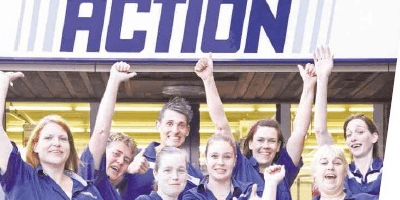Action: The incredibly complex endeavor of a simple store

Action – a discount store that sells everything from food and clothes to paint supplies and decorative glow-in-the-dark ducks – is the darling of the European market. It’s secret? One-off batches. A purposefully disorganized store. And 7 people in procurement.
108 new stores in 2014. 30% year-on-year revenue growth. European retailer of the year in 20151. Action – a Dutch discount store that sells everything from food and clothes to paint supplies and decorative glow-in-the-dark ducks – is the darling of the European market. It’s secret? A simple business model summarized by its slogan: “surprisingly comprehensive, amazingly affordable2”. And an operational model which does not only make an unrivaled low-price point possible, but also reinforces its appeal.
At the core, Action’s business model resembles that of a traditional retailer: it offers valued products at a small premium to procurement cost. Since Action is a discount retailer, their prices are highly competitive (e.g. leaving only 4.6% EBITDA margin1). That makes the business model surprisingly simple: create value by buying brands in large quantities at a discount, and capture value by filling stores with as much stock keeping units (SKUs) as possible, whilst maximizing store traffic.
But to understand what makes Action special, we need to investigate the company’s operating model. Three aspects in particular deserve further attention: its procurement process, its purposely disorganized store lay-out, and its lean organization.
The power of one-off batches
Large-scale centralized procurement processes are a must in discount retailing. Action takes it to another level. While some retailers structurally purchase 5,000 to 10,000 units of a certain item every month, Action makes one-off batch purchases of more than 250,0003. It also carefully times its purchasing behavior. For instance, if a shampoo changes its formula and all outdated bottles are returned to the producer, Action proactively offers to buy these items – at a vast discount3.
And that’s when it becomes particularly interesting: the impact of the procurement process on its in-store operations. Action made its store lay-out deliberately flexible to accommodate the large one-off batches. Whenever a new batch of (cheap) detergent is bought, the accompanying shelve spaces are expanded. As such, the stores can absorb large-scale batches easily, without facing out-of-store inventory build-up.
The procurement process in turn also reinforces its goal of high volume traffic and sales. Action stores on average have 100-150 new products each week1 – making 60% of the product assortment completely variable4. As such, customers are often ‘nudged’ into buying products now, for the fear of missing an amazing bargain; you never know if the highly-discounted product will still be there the next week. This perfectly aligns with Action’s goal of maximizing traffic and sales. As a testament to the impact: 90-95% of the people that walk into the store, purchase at least one item4. A conversion other retailers can only dream of.
The value of a purposefully disorganized store
Action goes further in managing the interaction between value capture and store design: most common purchasing items are in the back (e.g. dairy products and other traditional household goods), and the rest of the store has limited signs or clear ordering. In other words, to further spark impulsive purchasing behavior, Action stimulates customers to get “lost” in their store – preferably in the back. This is a delicate balancing act, exemplified when CEO Ronald van der Mark renovated stores to make them more organized. The result? Less sales, as people found their products too easily (resisting the temptation to buy other items), and the more pleasant lay-out made customers question the low-price nature of Action5.
How 7 people showcase Action’s focus on low costs
Action is an incredibly lean organization. The CEO does not have a car or a personal driver, celebrates achievements with carrot cake rather than champagne, and shies away publicity as much as possible6. The rest of the organization is similarly focused on low cost. Perhaps most strikingly: only 7 (!) employees in the procurement department are responsible for purchasing more than 1.5 billion euros of supplies4. Action’s advertising is also limited, but highly effective – it publishes its 100-150 new articles on the website each week, leading to 2.5 million unique visitors per month1 (equal to 15% of the Dutch population). Last, all retail locations are carefully screened to ensure they are at lowest rental cost possible7.
***
As a result of this fine balance between business and operating model, Action obtained a competitive price advantage, estimated to be about 35% cheaper than its nearest competitor3. However straightforward its business looks at first, Action is surprisingly intricate. As CEO Van der Mark remarked: “Everything has to stay as simply as it is now. That’s an incredibly complex endeavour”5.
SOURCES
- Action (2015). Annual Report 2015. Retrieved from: https://view.publitas.com/action-1/corporate-brochure/page/4-5
- 3i (2015). Portfolio: Action. Retrieved from: http://www.3i.com/our-business/private-equity/portfolio/action
- Elsevier (2015). “Action keeps growing”. Retrieved from: http://www.elsevier.nl/Economie/achtergrond/2015/4/Action-blijft-groeien-waarom-discounter-het-zo-goed-doet-1755378W/
- AD 1 (2015). “The secret of the success of Action is brilliant procurement”. Retrieved from: http://www.ad.nl/ad/nl/1100/Consument/article/detail/3849102/2015/02/11/Het-geheim-van-het-succes-van-Action-briljante-inkopers.dhtml
- FD (2015). “Drifting to the middle is that largest danger for us”. Retrieved from: http://fd.nl/ondernemen/1102347/afdrijven-naar-het-midden-van-de-markt-is-het-grootste-gevaar-voor-ons
- AD 2. (2015) “The Success of Action – Buddha a hit, whilst turtle flops”. Retrieved from: http://www.ad.nl/ad/nl/1100/Consument/article/detail/3992833/2015/05/01/Het-succes-van-Action-Boeddha-n-hit-schildpad-flopt.dhtml
- MT (2015). “The Silent Success of Action”. Retrieved from: http://www.mt.nl/157/36685/magazine/het-stille-succes-van-action.html



Very clever usage of consumer psychology to drive impulsive purchases and repeat visits! Not sure if they have plans to get on the e-commerce channel, but if so, I’d be curious to see which psychology insights would carry over in that space…